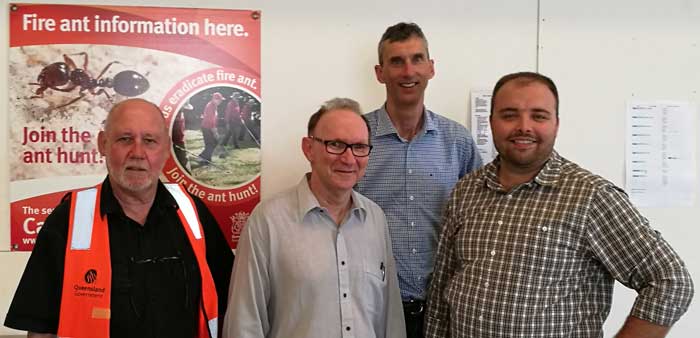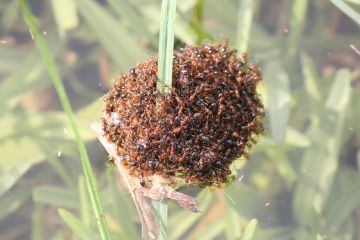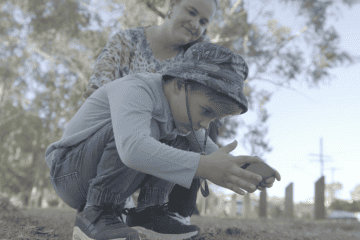
In late July Australia’s nine federal, state and territory agriculture ministers signed off a ten-year, $411 million red fire ant eradication program.
[toggle title_open=”Close” title_closed=”Send a message of thanks to Barnaby Joyce and your agriculture minister >>” hide=”yes” border=”yes” style=”default” excerpt_length=”0″ read_more_text=”Read More” read_less_text=”Read Less” include_excerpt_html=”no”]
Congratulate your agriculture minister
Sign the form below to send a thank-you message to state and federal agriculture ministers for the leadership they have demonstrated by supporting fire ant eradication.
Select your state and we will send your message (personalise it if you like) to the Deputy Prime Minister and agriculture minister, Barnaby Joyce, along with your own state or territory agriculture minister.
[/toggle]
It is a great victory in the battle against an insidious invasive species. It’s not the end of the fight though – it’s the beginning of a long hard road to a fire ant free Australia. What should we expect from the new eradication program?
In recent months new fire ant nests have been regularly found outside of Queensland’s containment zone.
In June a nest was discovered at Beerwah, 70km north of Brisbane on the Sunshine Coast. Another infestation at Carseldine in Brisbane’s northern suburbs was identified at a similar time. Earlier in the year nests were also found in the inner Brisbane suburb of Holland Park; fire ant nests had never been found here before.
The most recent find was at Lowood, 6km to the west of Queensland’s fire ant official containment area, called a biosecurity zone.
Fire ants on the move
Genetic testing shows the recent spate of fire ant discoveries are not “new infestations”, as some media outlets have reported, but in fact outbreaks from the Brisbane infestation, and almost certainly the result of human-assisted transportation.
It is also clear that the majority of sightings are the result of a community that is now far more aware of the fire ant threat and actively engaged in reporting and controlling their spread.
Unfortunately, people continue to carry high risk materials likely to carry fire ants such as soil, mulch, pot plants, turf and hay in and out of the biosecurity zone without the required permit and clearance procedures.
The eradication program should take a harder line discouraging the illegal movement of these high-risk materials and identify and prosecute those who break the rules.
Controlling hundreds of thousands of movements in and out of the containment area each day is obviously a huge challenge, but it is essential and needs to be backed by the Queensland government prepared to use legal authority to address these high-risk spread vectors.
Years of funding uncertainty, limited resources, and little community engagement will not be turned around quickly. We should expect many more fire ant discoveries outside the biosecurity zone over the coming months. It is a sign surveillance is working.
Securing fire ant funding a huge win
Australia’s agriculture ministers have agreed to take action on every recommendation listed in the 2016 independent review of the fire ant eradication program and, most importantly, the required $380 million ten-year funding ($38 million per year).
The federal government and all the states and territories actually approved $411 million after indexing for inflation. This gives the eradication program much needed funding security and the ability to confidently plan ahead and recruit and retain good staff.
While funding had been the main impediment, there is more to do regarding program oversight, consultation and information flow. Early signs from the program are promising:
- A new steering committee to “provide clear accountability and transparency” has been setup and held its first meeting in July. Later in the year an independent chair will be appointed.
- There is a greater willingness to publicise new fire ant reportings, meet with stakeholders and conduct community training in ant identification.
We are encouraging the program to formalise a stakeholder reference committee with representatives from industry, agriculture, the environmental sector and community representatives to provide better two-way communication.
Winning full funding for fire ant eradication was a huge achievement and we want to see it put to good use.
Fire ants are now under the national spotlight. We will continue to play a monitoring role as the eradication program moves forward and maintain our critical voice and independent analysis. There is too much at stake to fail on fire ant eradication.
[toggle title_open=”Close” title_closed=”Send a message of thanks to Barnaby Joyce and your agriculture minister >>” hide=”yes” border=”yes” style=”default” excerpt_length=”0″ read_more_text=”Read More” read_less_text=”Read Less” include_excerpt_html=”no”]
Congratulate your agriculture minister
Sign the form below to send a thank-you message to state and federal agriculture ministers for the leadership they have demonstrated by supporting fire ant eradication.
Select your state and we will send your message (personalise it if you like) to the Deputy Prime Minister and agriculture minister, Barnaby Joyce, along with your own state or territory agriculture minister.
[/toggle]



